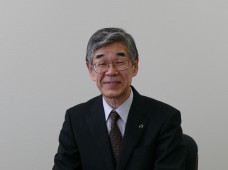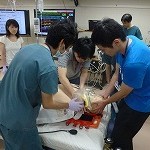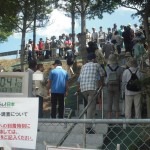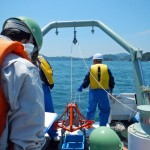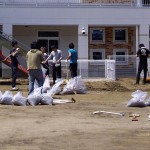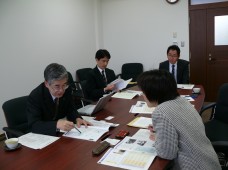2013.03.06
Interview with Tohoku University Vol. 1
In late November 2012, representatives from the United Nations Information Centre (UNIC Tokyo) visited Tohoku University to observe its disaster reconstruction efforts and initiatives toward realizing a sustainable society. It was the first trip since the United Nations Day was held at the university, in October 2011. In one short month after the earthquake and tsunami, Tohoku University established the Institute for Disaster Reconstruction and Regeneration Research and has been promoting cooperative projects ever since. UNIC Tokyo spoke to Prof. Nobuyoshi Hara, Executive Vice President for Tohoku University, about their efforts.
"The Institute for Disaster Reconstruction and Regeneration Research” aims to contribute to resolving disaster recovery issues common to all human kind, through interdisciplinary academic research. As the only university in the world to have experienced a disaster of this magnitude, we want to present our experiences to the society and help rebuild the region," said Prof. Hara, who spoke passionately about the the disaster-stricken Tohoku region and his university's mission to lead Japan's reconstruction efforts.
Disasters can happen anywhere in the world. The difficulties that Japan now faces are issues that the world may one day face as humankind pursues sustainability. Prof. Hara expressed his desire to harness the collective power of Tohoku University's 10 colleges, 16 graduate schools and 6 research institutes that span the humanities and sciences for the sake of the region's recovery: "As research advances, we will be able to transmit information that can help reduce the impact caused by disasters not only in Japan, but around the globe. We will run our projects for 10 years, which is longer than usual timeframe for a university project."
The projects, which are led by Tohoku University faculty members and students, will be operated in cooperation with a wide range of partners, including government agencies, local communities and businesses. Projects in the following eight fields are currently being pursued under the auspices of the Institute for Disaster Reconstruction.
- Establishment of the International Research Institute of Disaster Science to promote interdisciplinary international research
- Contribution to the revitalization of community medicine by developing community healthcare professionals and establishing a complex biobank that includes long-term health surveys of residents in affected areas
- Promotion of advanced, highly disaster-resistant community though next generation R& D in order to promote the reconstruction of Tohoku region.
- Solution of ICT infrastructure issues brought to light by the Great East Japan Earthquake
- Survey of the impact of the earthquake and tsunami on the marine environment and ecosystems aimed at rebuilding the fishing industry
- Development of technologies to restore human habitats contaminated with radioactive materials, evaluation of radiation levels in affected animals and survey of impact on ecosystems
- Communication of policy proposals and information pertaining to the solution of issues and the cultivation of innovative producers who can contribute to regional industrial promotion in order to restore Tohoku's regional industries and communities
- Utilization of university know-how, commercialization of ideas and other measures to reform and strengthen the industrial infrastructure that will serve as the foundation of regional economic recovery
Of these eight projects, Prof. Hara placed special emphasis on the establishment of the International Research Institute of Disaster Science.
He spoke enthusiastically about the university's mission by saying, "The primary thrust of this new Institute is twofold: to transmit information worldwide and engage in cooperation. The reason for this is because Tohoku University, on its own, does not possess sufficient power to build a new paradigm for preparedness for a massive disaster in light of the unprecedented scale of the Great East Japan Earthquake. The affected areas must cooperate with universities around Japan and the world as well as businesses and municipalities. That is why we want to proactively communicate information using the UNAI framework."
In addition to this, university faculty and staff launched their own recovery assistance project called Reconstruction Action 100+. One initiative being carried out under this banner is the Agri-Reconstruction Project, which the United Nations Information Centre also observed (Details on these interviews will be published separately).
Tohoku University is a comprehensive university located in the heart of the region affected by the 2011 disaster. By listening to Prof. Hara, the Centre was able to gain the University’s clear sense of mission to devote itself to the region's recovery.
* * * * *
Related Information
Tohoku University Commemorates Membership in United Nations Academic Impact (UNAI) by Co-Hosting United Nations Day 2011
To commemorate Tohoku University's membership in United Nations Academic Impact (UNAI), a United Nations Day Symposium was held on the university's campus on October 24, 2011. Aiming to share the lessons Tohoku had learned in the eight months since the Great East Japan Earthquake, the session featured discussions among academics as well as businesspersons, representatives from local municipalities, the general public, students and UN agencies in Japan. The biggest outcome of the UN Day event at Tohoku University was the proposal of several lessons and good practices for the recovery of the affected areas and the creation of a sustainable society. For details on this event, please refer to the booklet entitled “Learning from the 2011 Earthquake and Tsunami ‘Good Practices’ from Japan: Towards a Sustainable Future” (http://www.unic.or.jp/unic/news/2674/).
最近の記事
-
2024.04.26
国連経済社会理事会(ECOSOC)ユースフォーラム2024におけるアントニオ・グテーレス国連事務総長発言(ニューヨーク、2024年4月16日) -
2024.04.26
国連の新たな報告書、SDGsを救うための数兆ドルの開発投資の拡大を呼びかけ(2024年4月9日付プレスリリース・日本語訳) -
2024.04.26
4月25日付 外務省ODAメールマガジンに、佐藤広報官の寄稿が掲載されました -
2024.04.25
人間の安全保障に関する国連総会非公式会合におけるアントニオ・グテーレス国連事務総長発言(ニューヨーク、2024年4月2日) -
2024.04.25
4月19日付 NHK放送文化研究所の「文研ブログ」に、根本所長のインタビュー記事が掲載されました




